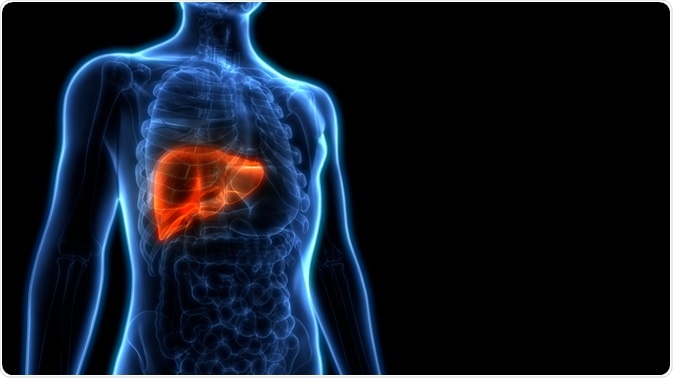The liver is not often regarded as having immunological properties. Scientists frequently recognize the metabolic, nutrient storage, and detoxification activities of the body’s largest solid organ, but rarely contemplate that the liver is heavily implicated in the functioning of the body’s immune system.

Liver. Image Credit: Magic mine/Shutterstock.com
There is a wide body of evidence that demonstrates that the liver is directly involved in developing immune tolerance and strong innate immunity. Its functioning is also related to the strength of the adaptive immune response. Much immunological activity takes place in the liver, with immune cells working in harmony with non-hematopoietic cells to govern this.
The Liver as an Immunological Organ
The liver acts as an intermediary between the content of the guts and systemic circulation. Around two-fifths of the body’s hepatic blood supply arrives at the gut from the portal vein. The low-pressure blood delivered via this pathway is packed with both dietary and environmental antigens in addition to molecules originating from the gut’s microflora. The structure of the liver has evolved to handle this immunogenic load while simultaneously remaining alert to detect pathogens and malignant cells.
The hepatic sinusoids located in the liver serve to drain the venous blood from the gut that mixes with that of the hepatic artery. Here, it is channeled to the central veins via plates of hepatocytes. Liver sinusoidal endothelial cells (LSEC) line the sinusoids, these structures allow blood to pass through into the hepatocytes below.
This specialized structure within the liver allows molecules to rapidly move from the blood into the hepatocytes. It also promotes the removal and breakdown of immunogenic molecules from the liver. Macrophages in the liver and pattern recognition receptors (PRR) bind to patterns that determine microbial associated molecular patterns (MAMP) and damage-associated molecular patterns (DAMP). These molecular patterns enter a stage of phagocytosis following binding, resulting in their subsequent degradation. This process protects the body from inordinate activation of the immune system and impacts the immunological environment of the liver.
The liver microenvironment and immune regulation
A specific cytokine/growth factor environment is generated in the liver as a result of its anatomical structure, which influences how the liver responds (via inflammation or tolerance). The hepatic blood supply acts as a significant factor impacting the liver microenvironment. Dietary and commensal molecules contained in this blood supply signal to cells in the liver and can bring about a state of tolerance.
Within the healthy human liver, an active and complex cytokine milieu is found, which is ever-present even in the absence of inflammation or infection. Studies have hinted that this cytokine milieu is a result of normal processes of the liver, such as PRR signaling and cytokine production induced by hepatic lymphoid immune cells. Additionally, this microenvironment is impacted further by the dietary fats and carbohydrates that exist in the hepatic blood supply.
In the liver, hepatocytes take up carbohydrates and store them as glycogen, and dietary fats that are converted into chylomicrons in the gut are transformed into lipoproteins that distribute cholesterol and triglycerides within the body. Each of these processes is directly related to inflammation of the liver.
Inflammatory processes and the liver
Immune cells within the liver, alongside non-hematopoietic cells, are vital to the mediation of the liver’s inflammatory response. Both of these cell types are implicated in the maintenance of homeostasis of the liver and the body. Homeostatic processes are vital to the liver’s inflammatory response, which is incredibly dynamic and complex and implicates a range of responses.
Scientists consider the healthy liver to be immunologically tolerogenic while possessing the ability to deliver rapid immune responses in the presence of certain factors. The liver’s myeloid cells are thought to be responsible, at least in part, for maintaining the organ’s hepatic tolerance. The liver’s macrophages, on the other hand, are known to produce anti-inflammatory cytokines in response to the presence of bacterial endotoxins. These cytokines act to downregulate the expression of the antigen-presenting cell’s (APCs) co-stimulatory molecules, resulting in limiting the liver’s adaptive immune response.
One of the main functions of the liver is to produce serum proteins. The healthy liver produces a range of proteins that are involved in the transportation of nutrients, regulation of osmotic blood pressure, and also act as precursors to several innate immune mediators. Also, the liver plays a vital role in detecting inflammatory signals originating in other areas of the body and responding to them. The liver’s hepatocytes can detect cytokines produced by the immune system in response to the presence of an invading pathogen and initiate the acute phase response (APR).
The immune response and the liver: what we know
Myeloid and lymphoid immune cell populations exist in the healthy human liver. Additionally, homeostasis of the organ, as well as systemic homeostasis, is influenced by the liver’s inflammatory mechanisms.
Further to this, while there is a bias towards immune tolerance, the liver’s hepatic immune cells are capable of initiating an inflammatory response to infection. Finally, the liver plays a vital role in recognizing the signals of inflammation in other parts of the body and initiating an immune response.
Sources:
- Bogdanos, D., Gao, B. and Gershwin, M., 2013. Liver Immunology. Comprehensive Physiology, 3(2), pp567–598. https://www.ncbi.nlm.nih.gov/pmc/articles/PMC4201126/
- Gao, B., 2016. Basic liver immunology. Cellular & Molecular Immunology, 13(3), pp.265-266. https://www.ncbi.nlm.nih.gov/pmc/articles/PMC4856812/
- Robinson, M., Harmon, C. and O’Farrelly, C., 2016. Liver immunology and its role in inflammation and homeostasis. Cellular & Molecular Immunology, 13(3), pp.267-276. https://www.nature.com/articles/cmi20163
Further Reading